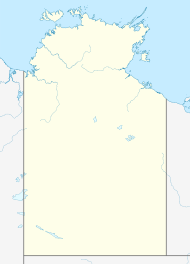John Flynn's Grave Historical Reserve (Alice Springs) facts for kids
Quick facts for kids John Flynn's Grave Historic ReserveFlynn, Northern Territory |
|
|---|---|

John Flynn's Grave, Alice Springs, Australia
|
|
| Nearest town or city | Alice Springs |
| Established | 21 March 1957 |
| Area | 0.34 hectares (0.84 acres) |
| Managing authorities | Parks and Wildlife Commission of the Northern Territory |
John Flynn's Grave Historical Reserve, often called Flynn's Grave, is where John Flynn is buried. He was an Australian Presbyterian minister. John Flynn started the Australian Inland Mission (AIM). He also founded the famous Royal Flying Doctor Service. This service brings medical help to people in remote areas.
The grave is now a special historical reserve. It is located at the bottom of Mount Gillen. You can find it on Larapinta Drive in the Alice Springs area called Flynn. The grave also marks the start of a walking path up Mount Gillen.
Contents
The Story of John Flynn's Grave
John Flynn passed away in Sydney on 5 May 1951. He had asked to be buried in Alice Springs. So, his ashes were flown there. They were first buried in a temporary spot near the current site.
A funeral was held on 23 May 1951. More than 500 people came to pay their respects. The permanent grave was finished in August 1953. His ashes were placed inside a new monument. A large boulder was then placed over it.
John Flynn's wife, Jean Flynn, chose to have a boulder cover the grave. She was inspired by a Bible story. This story tells of a large rock being rolled over Jesus's grave. Jean Flynn was later buried there too, on 14 November 1976. A plaque was also placed on the grave. It says Flynn "brought gladness and rejoicing to the wilderness."
The Sacred Stone Controversy
Finding a suitable boulder near Alice Springs was difficult. So, a large eight-tonne boulder was chosen from the Karlu Karlu / Devils Marbles Conservation Reserve. This reserve is about 400 kilometres north. However, this boulder was taken without permission. It belonged to the Traditional Owners of that land. These are the Warumungu and Kaytetye people.
The Warumungu and Kaytetye people believe these boulders have special powers. They worry that damaging or removing them can cause serious harm. The Arrernte people in Alice Springs also had concerns. They were worried about having this sacred stone on their land.
Protecting the Reserve
After the grave was completed, John Flynn's Grave Historical Reserve became official. This happened on 21 March 1957. It was later re-declared on 30 June 1978. The reserve is important because of John Flynn's Grave. But it also includes the Alkate Hills. This area is a sacred site for the Arrernte people.
Concerns about the sacred stone continued. In 1980-1981, meetings were held. The Uniting Church met with different Aboriginal representatives. They agreed to find a new boulder. But disagreements stopped this from happening right away.
Negotiations started again in 1996. The Central Land Council, the Uniting Church, and other groups worked together. These groups included the Aboriginal Areas Protection Authority and the Parks and Wildlife Commission of the NT. After a lot of effort, a new rock was found in late 1998.
This time, the Warumungu/Kaytetye stone was replaced with an Arrernte stone. This new stone is linked to the Arrernte people's Yeperenye (Caterpillar) Dreaming stories. The Arrernte people allowed this boulder to be used. They saw it as a "sincere sign of reconciliation." This means it was a sign of making peace and showing respect. The original boulder from Karlu Karlu was then returned to its home.
Official Recognition
The historical reserve has been officially recognized for its importance. It was listed on the now-closed Register of the National Estate on 21 October 1980. It was also added to the Northern Territory Heritage Register on 18 October 2003. These listings show that the site is valued for its history and culture.
See also


